Best keyboards for programmers of 2025
The best keyboards for programmers to take your coding to the next level

1. Best overall
2. Best ergonomic
3. Best portable
4. Best compact
5. Best wireless
6. Best for Mac
7. Best on a budget
8. FAQs
9. How we test
The best keyboards for programmers are built for comfort and designed to last. So, when you’re hammering away at your latest coding project, you won’t end up with muscle strains and fatigue from all the typing.
Given how much day-to-day use they get, keyboards are an essential tool for coding whether they’re standalone units or built into the best laptops for programming. If you want to stay productive while you work, it’s important to select a unit that fits your workflow, offering good feedback for touch-typing, programmable buttons for fast access, and keys configured to specialized use.
But with so many different choices, from the best business keyboards to those designed for coding, gaming, writing, and more, it can be hard to know which one can tackle the job in the best way. That’s why we’ve put the best keyboards for programmers to the test. As part of our rigorous review process, we’ve examined the keyboard type, size, switch types, and overall build quality. We’ve also assessed each board’s ergonomics for comfortable prolonged use.
The best keyboards for programmers of 2025 in full
Why you can trust TechRadar
Best keyboard for programmers overall
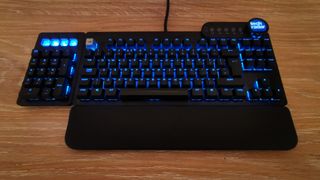
Specifications
Reasons to buy
Reasons to avoid
No two programmers that are identical: coders are used to modifying everything and pushing the limits in the virtual world. Now, thanks to the Mountain Everest Max keyboard, they can achieve customization nirvana in the physical realm too.
This keyboard pushes the envelope and innovates in areas where others have never ventured, starting with its most noticeable feature: the numeric keypad is detachable and can be placed on either side of the keyboard. The keycaps are replaceable with the included keycap puller tool and you can choose your favorite type of MX switches at purchase with MX Red, MX Brown, MX Blue, MX Silent Red and MX Speed Silver available. However, you can also swap switches by just pulling them out - no soldering required - if you're unhappy with the stock ones.
The Mountain Everest Max also features a "media dock" - a tiny keyboard plugged into the top right corner. It features a display dial for changing its configuration on the fly. On its tiny display you can see useful information like CPU usage or download speed, and display a custom image uploaded by you as a “screen saver” when idle. It also has media controls for adjusting volume or switching songs in the middle of a coding session.
The "Base Camp" software includes a Macro Wizard and editor, allowing you to bind custom keys to your favorite hotkeys or macros. It also allows for upgrading of the keyboard's firmware and changing its RGB lighting, as well as customizing the legends on the graphics keys.
For those long coding sessions, its PU-Leather covered palm rest with magnetic attachment is a godsend. Yes, it's pricey - but it's totally worth it.
Read our full Mountain Everest Max review.
Best ergonomic keyboard for programming

2. Kinesis Freestyle Pro
Specifications
Reasons to buy
Reasons to avoid
Standard keyboards can lead to pain and fatigue over the long term as well as nasty ailments. By allowing your hands to rest in a more relaxed position, ergonomic keyboards prevent strain and injuries. There are several ergonomic designs, with the fixed ones being the most prevalent. Split ergonomic keyboards take up less space and give you more freedom to adjust the position of your left and right arms when typing on a desk. They also allow you to keep your wrists straight, which reduces strain on the tendons, helping to prevent repetitive strain injuries (RSI).
The Kinesis Freestyle Pro combines a tenkeyless layout with a full row of function keys at the top and eight programmable macro keys on the left. As a mechanical keyboard, it features Cherry MX switches in two varieties: a version with Cherry MX Brown tactile switches with no click and another with Cherry MX Red linear switches -those preferred by gamers. It supports three key layouts: Windows, Mac, and Dvorak. Keycaps are included for Mac such as control, option and command keys, which replace the Windows and alt keys.
Tenting or lifting the middle part of the keyboard to get a more comfortable typing position is supported, and programmers will appreciate the location of the Home, Page Up and Down, End and Arrow keys. The big Escape button is just the cherry on top. The left-side macro keys on this keyboard come pre-programmed with several useful functions, such as the Desktop key that minimizes all apps and show your desktop, or the Last App key that Alt-Tabs back to your last open application. Additionally, there are dedicated keys for Cut, Copy, Paste, Delete, Undo, and Menu.
Best portable keyboard for programmers
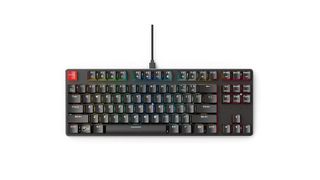
3. Glorious GMMK PRO
Specifications
Reasons to buy
Reasons to avoid
Those who prefer a smaller keyboard that is easier to carry can benefit from a tenkeyless version. The Glorious GMMK Pro comes in all three popular sizes: Full, Tenkeyless and Compact (61-key). We chose this version without a numeric keypad because it provides a balance of keys that programmers seek. The only difference between the three is the number of keys, but all share a beautiful design and technical aspects.
It's beauty is striking with an aluminum case that has a rich, sandblasted finish with raised keycaps. It is equipped with Gateron brown switches which are similar to Cherry Brown switches. The customization options for the Glorious GMMK Pro are great: you can swap out the switches, replacing them with any Cherry, Gateron or compatible switches and mix them if you want. As its braided cable is removable, it is easy to tuck into your backpack if necessary too.
Using the manufacturer's software, you can edit macros on the entire keyboard and customize the RGB lighting, but it is not required for operation. Most settings can be changed by using hotkeys with the Fn key. For instance, hitting Fn + Tab will switch the backlight on and off. Its most unique feature is its rotary knob that can adjust the volume of the sound but can also be pressed as a joystick.
This keyboard supports the open source QMK firmware, so you can remap all of its key mappings: moving around specific keys, adding functions and the like, as well as changing the function of the knob.
Best compact keyboard for programmers
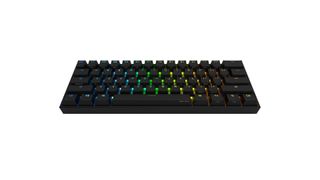
4. Obinslab Anne Pro 2
Specifications
Reasons to buy
Reasons to avoid
If you have limited desk space or are on the move switching locations during the day, you want a programming keyboard that is as small as possible while still retaining the feel and functionality of larger ones with standard desktop key sizes. The compact - or 60% - format keyboards are the most convenient way to achieve 104-key functionality with just 61 keys, via the use of key combinations. Yet not every programmer will like having to push two keys to get to the Function Keys or arrow keys while coding.
Available in White and Black and measuring only 11.2" by 3.8" inches the Anne Pro 2 is a compact marvel that can be used wired or wirelessly. It weighs only 635 grams (22.4 ounces) including the internal 1900mAh battery. The Bluetooth 4.0 connectivity can be turned on and off with a switch on its back and it can be paired with up to four devices. A nifty feature allows switching between paired systems by pressing the Fn2 key plus the numbers 1 to 4. This keyboard also works with Windows, Mac OS and Linux.
Various switch options are available from the manufacturer, and all of the keys can be macro-programmed using the software provided. Many programmers will like to go with Gateron Brown switches as they have a good amount of feedback and provide excellent typing without being too loud. There isn't a wrist rest or adjustable incline settings on this keyboard, but users report that you can use a 12-inch keyboard wrist rest from another manufacturer, like Glorious.
Because not every programmer prefers a 61-key layout, we have left the choice of the best portable keyboard for programmers up to you: tenkeyless or compact.
Best wireless keyboard for programmers
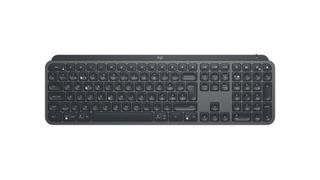
5. Logitech MX Keys
Specifications
Reasons to buy
Reasons to avoid
People looking for a wireless mechanical keyboard better skip this entry entirely: there are mechanical keyboards that are also wireless on this same buying guide. Yet Logitech has surprised us with a tried "rubber dome and scissors" mechanism used in most laptop keyboards. And they did an amazing job at it: its spherically dished keys feel great on your fingertips for long hours of programming.
It comes either with or without the bundled wrist rest and the price difference is only $19 at the time of this writing. We choose the one with the added wrist rest that is made of memory foam -a comfortable yet durable material that is soft and resilient- that allows your hands to be in a relaxed position while you code for hours.
Its scissors mechanism delivers satisfying feedback on every key press. The keys have a short travel distance, requiring little force when tapped. Like most scissor keyboards on laptops it is very quiet, so your fellow coders won't be bothered by your typing. It features exceptional compatibility: Windows, Mac OS, Linux, Android and iPhone, and can be paired with up-to 3 devices over Bluetooth. Three dedicated keys allow you to switch effortlessly between paired devices 1/2/3.
A number of unique features, including hand proximity detection and automatic backlighting -to conserve battery life- make it stand out from the rest. Unfortunately its programmable buttons can be assigned only to preset functions, not macros. But as programmers, you know that there's third party software for that. A 2.4 Ghz USB receiver is included that you can plug into your PC if you want to have less lag than over Bluetooth.
Its battery life is impressive, Logitech claims it can go up for over a week without recharging with backlighting enabled and up to five months with backlight off. Impressive indeed!
Best Mac keyboard for programmers
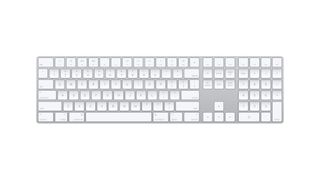
6. Apple Magic Keyboard with Keypad
Specifications
Reasons to buy
Reasons to avoid
Even though PC keyboards can be used with a Mac, you lose Apple-only keycaps such as the Option and Command keys. There are some mechanical keyboards that include replacement keycaps for Mac users. However, with a decent option from Apple, why bother?
The Apple Magic Keyboard with Numeric Keypad -magic keyboard NK hereinafter - features a broader layout that will appeal to most programmers, with document navigation controls for quick code scrolling and full-size arrow keys. The Magic Keyboard NK is 5.5 inches longer than the standard Magic Keyboard. As with any Magic Keyboard, the insides are similar: a scissor mechanism below each key and an extremely short key travel distance.
It is possible to use the device while it is plugged in and charging, but once the device is fully charged, it can be used wirelessly and its battery can last up to a month without charging. It comes with a USB-C to Lightning cable that measures three inches long. It is true that most if not all mechanical keyboards work with Macs too, but buying one is more of a hobby than a necessity.
Best keyboard for programmers on a budget
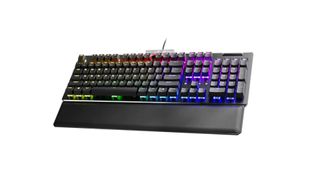
7. EVGA Z15
Specifications
Reasons to buy
Reasons to avoid
Programmers who don't want to spend a great deal of money can get great value from the EVGA Z15 in the mechanical keyboard category. For those taking the leap from membrane and rubber domes to mechanical wonders, it is ideal.
It looks and feels strong thanks to its brushed metal plate over a plastic base. The magnetically-attached wrist rest serves the purpose of keeping hands comfortable while typing long stretches of code. However, since it is made of hard plastic, it is not as comfortable as ones made of soft materials. It provides good ergonomics, since there are two incline settings and the keycaps are slightly curved.
Hot-swappable switches allow you to select the most appropriate switch based on your requirements. The RGB lighting illuminates the legends at night to make them easier to read, which along with media keys and its volume control wheel will please coders with a passion for music.
It has complete programmability meaning that you can set macros to any key. On the downside, its cord is not detachable but given the price, its an acceptable compromise.
Best keyboards for programmers: FAQs
What are the different types of keyboard?
There are three main switch types: membrane, rubber dome, and mechanical.
Membrane keyboards are the cheapest to manufacture and have a rubbery feeling. Membrane keyboards also lack the strong build of the other options, so may prove to have a shorter lifespan.
Most laptop keyboards have a scissor mechanism on the keycaps, on top of rubber domes, on top of a membrane. In other words, when you hear the term "membrane keyboard," it's usually a rubber dome. These keyboards are also silent which makes them good in certain situations, but they won't last as long and - with very few exceptions - they provide little or no customization.
With a mechanical keyboard, you have a separate switch below every key, which means the whole mechanism is more reliable and you can type much more comfortably by having better tactile feedback, making long coding sessions less stressful and more enjoyable. On top of that you get lots of customization options, from easily replaceable keycaps to programmable function keys.
When exploring which keyboard is best for programmers, we've tended towards mechanical units. Their lifespan is measured in decades rather than years, and provide you with the ability to exchange keycaps, change switches for a different feel, and a choice of noise levels based on the different types of mechanical switches.
How to choose the best programming keyboard for you
When choosing the best keyboard for programmers for you, start with considering the size. Do you want a full size keyboard, which tend to be best for extended use, or a tenkeyless design for additional portability? Are you after the best mechanical keyboards or do you prefer the near-silent membrane keys?
You'll want to check the connectivity of your keyboard. If it's a wireless model, connectivity will be easy and you'll have a neat wire-free look. But with wireless keyboards, you'll want to check the type of battery they use. Replaceable batteries are suitable options if you want to use the keyboard for a long time. Wired models will not need battery replacements, but you'll also have wire tangles to take care of.
Look out for additional features like dedicated media keys, customizable backlight, overall ergonomics, and pricing.
How we test the best keyboards for programmers
We've tested, reviewed, and rated a host of keyboards for different uses, including the best wireless keyboards, best mini keyboards, and even the best keyboards for general use.
Our expert reviewers also have extensive experience in testing out hardware and software designed specifically for coding, such as the best monitors for programming and the best text editors for coding - so we know what you're looking for and what you want to avoid.
We undertake the same strident testing process for all keyboard units - and having reviewed so many, there are core factors and features we look for. This includes:
Responsiveness: Every programmer has their own liking of tactile feedback and keycap type. A good tactile feedback helps reduce typos and improves productivity.
Reliability: The unit should work consistently, survive the accidental coffee or beverage spill - as part of this, we test overall build quality and judge the quality of materials used in its construction.
Customization: Power users need programmable keyboards with custom keys that can be modified to launch certain code editor features and actions. Others like extending the customization to keycaps as well.
Mechanical keyboards with easily replaceable keycaps allow switching the layout from the standard QWERTY. There's the complex-to-learn yet easy-on-your-fingers "DVORAK" layout, or the new "Colemak" layout which can simply be described as "QWERTY that has been fixed for speed typing".
Comfort: We appreciate that this factor can be subjective. Some programmers prefer a full-size keyboard with a numeric keypad, others prefer the smaller "tenkeyless" type, while for others "less is more" and prefer to have a 60% format not taking over their whole desk.
But mechanical keyboards are not to everyone’s liking. Laptops still ship with tried and true rubber dome and scissors design, and there’s some worthy desktop keyboards that are still not mechanical. While you might shell out over $100 for a mechanical keyboard with plenty of customization features, a non-mechanical keyboard with similar features can be had for a fraction of the price. If you like a quiet work environment, your wallet is thin, and you'd rather buy a new keyboard when it starts malfunctioning, then the old rubber dome might be for you.
But aren't the rubber dome keyboards membrane? And aren't membranes bad? Well, these days, the standard keyboard is a membrane with a rubber dome on top. The rubber domes return the key to the up position by acting as a spring. The keycaps of a laptop keyboard usually consist of a scissor mechanism on top of rubber domes, on top of a membrane. As such, nowadays, "membrane keyboard" usually refers to rubber dome keyboards.
With this criteria, we selected the best keyboard for Mac programmers, the best ergonomic keyboard for heavy coders, the best portable and the absolute best mechanical keyboard for programmers. Our tests also include adding options for every desk size, typing style and customization needs. We also selected the best budget category for the new programmers who don't want to break the bank.
Get in touch
- Want to find out about commercial or marketing opportunities? Click here
- Out of date info, errors, complaints or broken links? Give us a nudge
- Got a suggestion for a product or service provider? Message us directly
- You've reached the end of the page. Jump back up to the top ^
Are you a pro? Subscribe to our newsletter
Sign up to the TechRadar Pro newsletter to get all the top news, opinion, features and guidance your business needs to succeed!

Steve is TechRadar Pro’s B2B Editor for Creative & Hardware. He began in tech journalism reviewing photo editors and video editing software at the magazine Web User, where he also covered technology news, features, and how-to guides. Today, he and his team of reviewers test out a range of creative software, hardware, and office furniture. Once upon a time, he wrote TV commercials and movie trailers. Relentless champion of the Oxford comma.
- Fernando Cassia
- Lewis MaddisonReviews Writer